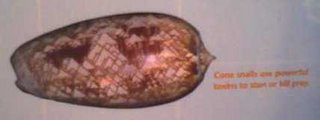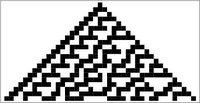 Did you know that the Delaware Museum of Natural History has a top ten collection of mollusks and birds? I am proud of my regional museum. In the rows and rows of mollusk shells on display I ran across this cone snail shell whose triangular patterns immediately reminded me of figures I have seen of cellular automata.
Did you know that the Delaware Museum of Natural History has a top ten collection of mollusks and birds? I am proud of my regional museum. In the rows and rows of mollusk shells on display I ran across this cone snail shell whose triangular patterns immediately reminded me of figures I have seen of cellular automata.Cellular automata are built on a grid from simple rules that depend on only the nearest neighbor values. A table of the outcomes for each of the eight possibilities can be built and is designated by the decimal equivalent of the binary values. This example is rule 30.

 Then you can build a pattern based on these rules. Rule 30 is an interesting one because it has chaotic, interesting behavior.
Then you can build a pattern based on these rules. Rule 30 is an interesting one because it has chaotic, interesting behavior.
 So now compare a closeup of the cone snail shell to the (upside down) results of cellular automata rule 30. Mother nature uses these simple rules, built up by overlapping dynamic chemical reactions, and controlled by biology to put designs on shells, spots on leopards, and stripes on zebras.
So now compare a closeup of the cone snail shell to the (upside down) results of cellular automata rule 30. Mother nature uses these simple rules, built up by overlapping dynamic chemical reactions, and controlled by biology to put designs on shells, spots on leopards, and stripes on zebras.tags: cellular automata, biology, math, science, cone snail
No comments:
Post a Comment